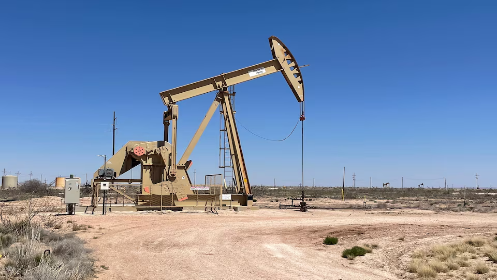As leaders gather for a global climate summit, investors are rewarding oil giants like Exxon Mobil that did not embrace wind and solar.
When oil and gas companies made ambitious commitments four years ago to curb emissions and transition to renewable energy, their businesses were in free fall.
Demand for the fuels was drying up as the pandemic took hold. Prices plunged. And large Western oil companies were hemorrhaging money, with losses topping $100 billion, according to the energy consulting firm Wood Mackenzie.
Renewable energy, it seemed to many companies and investors at the time, was not just cleaner — it was a better business than oil and gas.
“Investors were focused on what I would say was the prevailing narrative around it’s all moving to wind and solar,” Darren Woods, Exxon Mobil’s chief executive, said in an interview with The New York Times last week at a United Nations climate conference in Baku, Azerbaijan. “I had a lot of pressure to get into the wind and solar business,” he added.
Mr. Woods resisted, reasoning that Exxon did not have expertise in those areas. Instead, the company invested in areas like hydrogen and lithium extraction that are more akin to its traditional business.
Wall Street has rewarded the company for those bets. The company’s stock price has climbed more than 70 percent since the end of 2019, lifting its market valuation to a record of nearly $560 billion in October, though it has since fallen to about $524 billion.
The American oil giant’s performance stands in contrast with BP and Shell, oil and gas companies based in London that embraced wind, solar and other technologies like electric-vehicle charging. BP’s stock has fallen around 19 percent in that time, based on trading in London, while Shell’s has climbed about 15 percent.
The market’s renewed acceptance of fossil fuels underscores one of the core challenges of curbing global emissions: Climate change poses risks that compound over decades. Scientists say every fraction of a degree of warming caused by fossil fuels brings greater risks from deadly heat waves, wildfires, drought, storms and species extinction. But investors are focused on making money over months and years.
“If we want to combat climate change, we need to make it in the firms’ and consumers’ self-interest to produce and buy the low-carbon alternatives,” said Christopher Knittel, a professor of energy economics at the Massachusetts Institute of Technology.
The election of Donald J. Trump, who has falsely described global warming as a hoax, has led to even greater optimism about the oil and gas business.
The difference in profits that companies can make from extracting oil and gas and what they can earn from harnessing wind and solar had already swung sharply in favor of fossil fuels in recent years.
The median return on capital among some of the world’s biggest investor-owned oil companies, a key measure of profitability, topped 11 percent last year, up from negative 8 percent in 2020, according to an analysis by S&P Global Commodity Insights. The median return over that same period for the top renewable energy companies has stayed around 2 percent.
Where the Money Is for Energy Companies
Investors pushed oil and gas companies toward renewable energy around the pandemic. But Wall Street changed its tune when oil and gas profits rebounded.
“If you look at the relative shareholder returns, the market’s been sending a very clear signal that it wants energy companies to focus on their core competencies,” said Mark Viviano, a managing partner at Kimmeridge, an energy investment firm based in Denver and New York. “That doesn’t mean abandoning the energy transition, but it just means being more pragmatic about it.”
BP pledged in 2020 to cut its oil and gas production 40 percent by the end of the decade. Less than three years later, it backtracked and said it would increase spending on fossil fuels. The company wrote off $1.1 billion in offshore wind investments last year and recently said it wanted to sell other wind assets, though it continues to invest in renewable energy.
“We will be very, very returns-focused, making sure that the new businesses compete on a competitive level with the historic businesses for scarce capital,” the company’s chief executive, Murray Auchincloss, told financial analysts on a recent conference call.
Shell has softened or discarded some of its emissions-reduction targets, as it scaled back growth expectations for its renewable power business.
“We do not see ourselves as being advantaged in renewable generation to create material returns over others,” Wael Sawan, Shell’s chief executive, told analysts recently. “And so you do see us stepping back.”
In the United States, where environmentally conscious investing has become increasingly politicized, investors have gone from regularly quizzing oil and gas executives about their energy transition plans to zeroing in on projects that are more likely to lift the bottom line soon, executives said.
“Some people jumped the gun and moved toward some paths that ultimately turned out to be, I’d say, devastating to their bottom line,” Toby Rice, the chief executive of a Pittsburgh natural gas producer, EQT, said in an interview. “They’ve now come back to center.”
That said, the oil and gas business is subject to wild price swings that can quickly make fortunes and dash them just as rapidly. Before the Covid-19 pandemic, investors turned away from domestic producers after sustaining bruising losses as the companies chased production growth. Renewable energy tends to be a far steadier business.
Investors still widely expect oil and gas companies to curb their emissions by, among other things, plugging leaks of methane, a potent greenhouse gas. And around the world, nearly twice as much money is being invested in clean energy as in fossil fuels, according to the International Energy Agency, a Paris-based organization whose members include the United States and other industrialized countries.
“The end goal here I think is still widely endorsed,” said Dan Pickering, chief investment officer at Pickering Energy Partners, an investment firm based in Houston. “We’re oscillating around an upward slope.”
Next year may pose a test for oil companies and their shareholders.
U.S. crude prices have slipped below $70 a barrel, from around $78 last year, squeezing corporate profits. Next year, global production is likely to be more than one million barrels a day higher than demand, the I.E.A. said last week.
“Let’s see how these companies do if the price of oil goes back down,” said Amy Myers Jaffe, director of the Energy, Climate Justice and Sustainability Lab at New York University.







